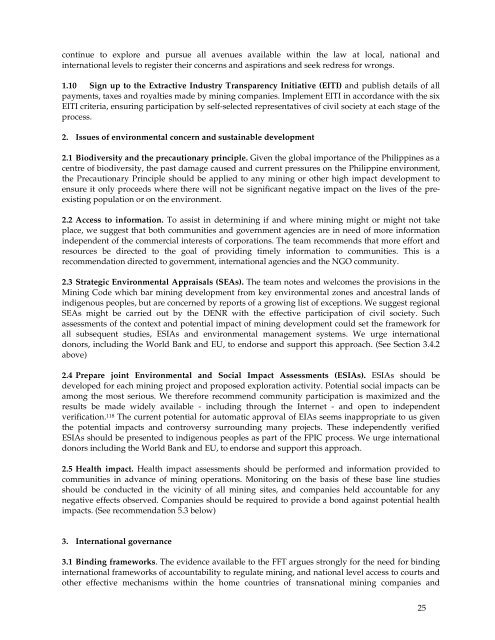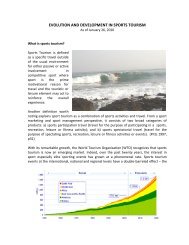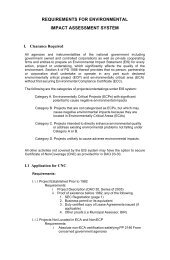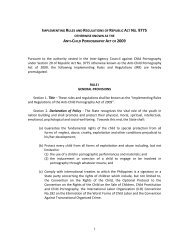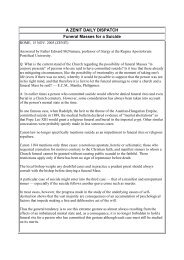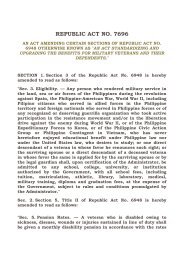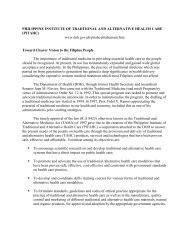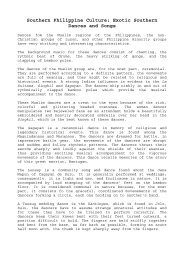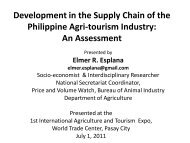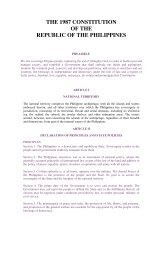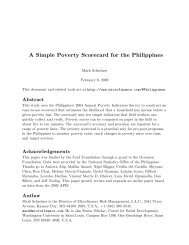Mining in the Philippines - Concerns and Conflicts
Mining in the Philippines - Concerns and Conflicts
Mining in the Philippines - Concerns and Conflicts
Create successful ePaper yourself
Turn your PDF publications into a flip-book with our unique Google optimized e-Paper software.
cont<strong>in</strong>ue to explore <strong>and</strong> pursue all avenues available with<strong>in</strong> <strong>the</strong> law at local, national <strong>and</strong><br />
<strong>in</strong>ternational levels to register <strong>the</strong>ir concerns <strong>and</strong> aspirations <strong>and</strong> seek redress for wrongs.<br />
1.10 Sign up to <strong>the</strong> Extractive Industry Transparency Initiative (EITI) <strong>and</strong> publish details of all<br />
payments, taxes <strong>and</strong> royalties made by m<strong>in</strong><strong>in</strong>g companies. Implement EITI <strong>in</strong> accordance with <strong>the</strong> six<br />
EITI criteria, ensur<strong>in</strong>g participation by self-selected representatives of civil society at each stage of <strong>the</strong><br />
process.<br />
2. Issues of environmental concern <strong>and</strong> susta<strong>in</strong>able development<br />
2.1 Biodiversity <strong>and</strong> <strong>the</strong> precautionary pr<strong>in</strong>ciple. Given <strong>the</strong> global importance of <strong>the</strong> Philipp<strong>in</strong>es as a<br />
centre of biodiversity, <strong>the</strong> past damage caused <strong>and</strong> current pressures on <strong>the</strong> Philipp<strong>in</strong>e environment,<br />
<strong>the</strong> Precautionary Pr<strong>in</strong>ciple should be applied to any m<strong>in</strong><strong>in</strong>g or o<strong>the</strong>r high impact development to<br />
ensure it only proceeds where <strong>the</strong>re will not be significant negative impact on <strong>the</strong> lives of <strong>the</strong> preexist<strong>in</strong>g<br />
population or on <strong>the</strong> environment.<br />
2.2 Access to <strong>in</strong>formation. To assist <strong>in</strong> determ<strong>in</strong><strong>in</strong>g if <strong>and</strong> where m<strong>in</strong><strong>in</strong>g might or might not take<br />
place, we suggest that both communities <strong>and</strong> government agencies are <strong>in</strong> need of more <strong>in</strong>formation<br />
<strong>in</strong>dependent of <strong>the</strong> commercial <strong>in</strong>terests of corporations. The team recommends that more effort <strong>and</strong><br />
resources be directed to <strong>the</strong> goal of provid<strong>in</strong>g timely <strong>in</strong>formation to communities. This is a<br />
recommendation directed to government, <strong>in</strong>ternational agencies <strong>and</strong> <strong>the</strong> NGO community.<br />
2.3 Strategic Environmental Appraisals (SEAs). The team notes <strong>and</strong> welcomes <strong>the</strong> provisions <strong>in</strong> <strong>the</strong><br />
<strong>M<strong>in</strong><strong>in</strong>g</strong> Code which bar m<strong>in</strong><strong>in</strong>g development from key environmental zones <strong>and</strong> ancestral l<strong>and</strong>s of<br />
<strong>in</strong>digenous peoples, but are concerned by reports of a grow<strong>in</strong>g list of exceptions. We suggest regional<br />
SEAs might be carried out by <strong>the</strong> DENR with <strong>the</strong> effective participation of civil society. Such<br />
assessments of <strong>the</strong> context <strong>and</strong> potential impact of m<strong>in</strong><strong>in</strong>g development could set <strong>the</strong> framework for<br />
all subsequent studies, ESIAs <strong>and</strong> environmental management systems. We urge <strong>in</strong>ternational<br />
donors, <strong>in</strong>clud<strong>in</strong>g <strong>the</strong> World Bank <strong>and</strong> EU, to endorse <strong>and</strong> support this approach. (See Section 3.4.2<br />
above)<br />
2.4 Prepare jo<strong>in</strong>t Environmental <strong>and</strong> Social Impact Assessments (ESIAs). ESIAs should be<br />
developed for each m<strong>in</strong><strong>in</strong>g project <strong>and</strong> proposed exploration activity. Potential social impacts can be<br />
among <strong>the</strong> most serious. We <strong>the</strong>refore recommend community participation is maximized <strong>and</strong> <strong>the</strong><br />
results be made widely available - <strong>in</strong>clud<strong>in</strong>g through <strong>the</strong> Internet - <strong>and</strong> open to <strong>in</strong>dependent<br />
verification. 118 The current potential for automatic approval of EIAs seems <strong>in</strong>appropriate to us given<br />
<strong>the</strong> potential impacts <strong>and</strong> controversy surround<strong>in</strong>g many projects. These <strong>in</strong>dependently verified<br />
ESIAs should be presented to <strong>in</strong>digenous peoples as part of <strong>the</strong> FPIC process. We urge <strong>in</strong>ternational<br />
donors <strong>in</strong>clud<strong>in</strong>g <strong>the</strong> World Bank <strong>and</strong> EU, to endorse <strong>and</strong> support this approach.<br />
2.5 Health impact. Health impact assessments should be performed <strong>and</strong> <strong>in</strong>formation provided to<br />
communities <strong>in</strong> advance of m<strong>in</strong><strong>in</strong>g operations. Monitor<strong>in</strong>g on <strong>the</strong> basis of <strong>the</strong>se base l<strong>in</strong>e studies<br />
should be conducted <strong>in</strong> <strong>the</strong> vic<strong>in</strong>ity of all m<strong>in</strong><strong>in</strong>g sites, <strong>and</strong> companies held accountable for any<br />
negative effects observed. Companies should be required to provide a bond aga<strong>in</strong>st potential health<br />
impacts. (See recommendation 5.3 below)<br />
3. International governance<br />
3.1 B<strong>in</strong>d<strong>in</strong>g frameworks. The evidence available to <strong>the</strong> FFT argues strongly for <strong>the</strong> need for b<strong>in</strong>d<strong>in</strong>g<br />
<strong>in</strong>ternational frameworks of accountability to regulate m<strong>in</strong><strong>in</strong>g, <strong>and</strong> national level access to courts <strong>and</strong><br />
o<strong>the</strong>r effective mechanisms with<strong>in</strong> <strong>the</strong> home countries of transnational m<strong>in</strong><strong>in</strong>g companies <strong>and</strong><br />
25


